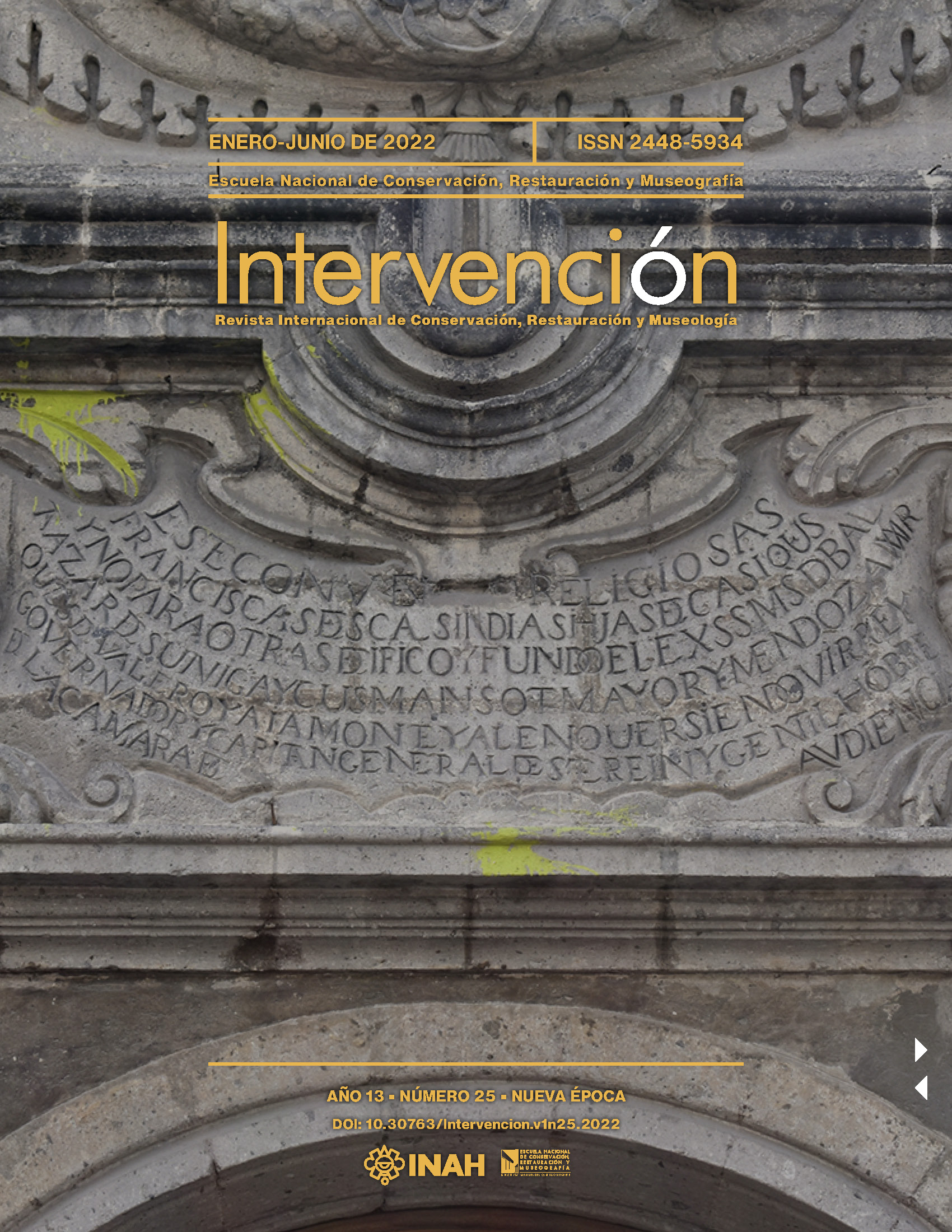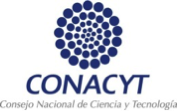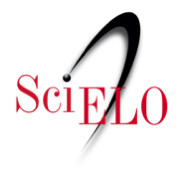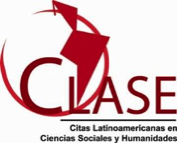Initial Assessment of the Properties of Nopal Gum as a Possible Additive in the Conservation of Adobe Buildings
DOI:
https://doi.org/10.30763/Intervencion.264.v1n25.43.2022Keywords:
nopal gum, adobe, capillarity, strength, cohesionAbstract
This research article exposes a possible application of the nopal gum (Opuntia ficus) variety as an additive to promote the durability of adobes, which may be used in the conservation of architectural heritage. This research was carried out in the Laboratory on Cubic Soil Specimens. While preparing the mixtures, different concentrations of previously dehydrated and powdered nopal gum were added. Through moisture retention, capillarity, and compressive strength analysis, the samples were evaluated, and the results found—also discussed here—show that adding nopal gum increases the compression strength of soil specimens and reduces capillarity. In fact, it was possible to maintain the cohesion of the particles in the soil samples during their exposure to humid environments. Having obtained such aptitude in the properties of said specimens makes this substance viable for its use in the conservation of adobe buildings.
Downloads
References
ASTM C117-95. (1995). “Standard Test Method for Materials Finer than 75-µm (No. 200) Sieve in Mineral Aggregates by Washing”. American Society for Testing and Materials, ASTM International.
ASTM C136-01. (2017). “Método de Ensayo Normalizado para determinar el Análisis Granulométrico de los Áridos Finos y Gruesos”. American Society for Testing and Materials, ASTM International.
ASTM D4318-05. (2005). “Standard Test Methods for Liquid limit, Plastic Limit, and Plasticity index of Soils”. American Society for Testing and Materials, ASTM International.
ASTM D698-12 (2021). “Standard Test Method for Laboratory Compaction Characteristics of Soil Using Standard Effort (12,400 ft-lbt/ft3 (600 kN-m/m3))”. American Society for Testing and Materials, ASTM International.
Barba, L. y Villaseñor, I. (2013). La cal. Historia, propiedades y usos. Universidad Nacional Autónoma de México/Instituto de Investigaciones Antropológicas.
Bardou, P. y Arzoumanian, V. (1979). Arquitecturas de adobe. Gustavo Gili.
Chang, I., Im, J. y Cho, G-C. (2016). Geotechnical engineering behaviors of gellan gum biopolymer treated sand. Can Geotech J, 53(10), 1658–1670. doi: https://doi.org/10.1139/cgj-2015-0475
Daneels, A. y Guerrero, L. (2013). La Joya, Veracruz, un sitio prehispánico construido con tierra: sistemas constructivos y pruebas de preservación en trópico húmedo. Intervención. Revista internacional de conservación, restauración y museología, 3(6), 34-43. doi: https://doi.org/10.30763/Intervencion.2012.6.72
Gheribi, R., Puchot, L., Verge, P., Jaoued-Grayaa, N., Mezni, M., Habibi y Khwaldia, K. (15 de junio, 2018). Development of plasticized edible films from Opuntia ficus-indica mucilage: A comparative study of various polyol plasticizers. Carbohydrate Polymers 190, 204-211. doi: https://doi.org/10.1016/j.carbpol.2018.02.085
Guillen, J., García De León, E., Ortiz, N., Escudero, R. y Rojas-Valencia, M. (junio, 2019). Study of the properties of the Echerhirhu-Block made with Opuntia ficus mucilage for use in the construction industry. Case Studies in Construction Materials 10, e00216. doi: https://doi.org/10.1016/j.cscm.2019.e00216
Instituto Nacional de Antropología e Historia. (2014). Lineamientos institucionales generales en materia de conservación del patrimonio cultural. México, Instituto Nacional de Antropología e Historia. https://www.normateca.inah.gob.mx/pdf/01472572392.PDF
Jáidar, Y. (2006). Los extractos vegetales usados como aditivo en los morteros de cal con fines de conservación (Tesis de licenciatura). Escuela Nacional de Conservación, Restauración y Museografía “Manuel del Castillo Negrete”, Instituto Nacional de Antropología e Historia.
Jani, G., Shahb, D., Prajapatia, V. y Jain, V. (2009) Gums and mucilages: versatile excipients for pharmaceutical formulations. Gums and mucilages/Asian Journal of Pharmaceutical Sciences. 4(5), 308-322. http://citeseerx.ist.psu.edu/viewdoc/download?doi=10.1.1.472.4557&rep=rep1&type=pdf
Khachatoorian, R., Petrisor, I. G., Kwan, C. C. y Fu, T. (2003). Biopolymer plugging effect: laboratory-pressurized pumping flow studies. Journal of Petroleum Science and Engineering, 38(1-2), 13-21. doi: https://doi.org/10.1016/S0920-4105(03)00019-6
Lemboye, K., Almajed, A., Alnuaim, A., Arab, M. y Alshibli, K. (febrero, 2021). Improving sand wind erosion resistance using renewable agriculturally derived biopolymers. Aeolian Research 49, 100663. doi: https://doi.org/10.1016/j.aeolia.2020.100663
Lobos E., Passos da Silva, D., Mena, J., Logarzo, G. y Varone, L. (enero 2013). Principales insectos plagas de las Opuntias en Argentina, México y Brasil. Cactusnet Newsletter, Número especial 13, 137-58. http://www.i-m.mx/cactusnet/Cactusnet/newsletter.html
Martínez-Camacho, F., Vázquez-Negrete, J., Lima, E., Lara, V. y Bosch, P. (2008). Texture of nopal treated adobe: restoring Nuestra Señora del Pilar mission. Journal of Archaeological Science, 35(5), 1125-1133. doi: https://doi.org/10.1016/j.jas.2007.10.019
Medina-Torres, L., Brito-De La Fuente, E., Torrestiana-Sanchez, B. y Katthain, R. (2000). Rheological properties of the mucilage gum (Opuntia ficus indica). Food Hydrocolloids, (14), 417-424. doi: https://doi.org/10.1016/S0268-005X(00)00015-1
Medina, O., Carrascosa, B. y Domenech, M. T. (2015). Estudio de la influencia de aditivos naturales obtenidos de plantas crasas en las propiedades de morteros de adobe. Arché, (10), 170-178. http://hdl.handle.net/10251/85216
MMP-1 02/03. (2003). Clasificación de fragmentos de rocas y suelos en Métodos de muestreo y prueba de materiales. Secretaría de Comunicaciones y Transportes (SCT).
Muguda, S., Booth, S. J., Hughes, P. N., Augarde, C. E., Perlot, C., Bruno, A. W. y Gallipoli D. (2017). Mechanical properties of biopolymer-stabilised soil-based construction materials. Géotechnique Letters, 7, 309-314. doi: https://doi.org/10.1680/jgele.17.00081
Nazareno, M. A. (2013). Cactus como fuente de sustancias promotoras de la salud. Cactusnet Newsletter, 13, 95-105. http://www.i-m.mx/cactusnet/Cactusnet/newsletter.html
Organización de las Naciones Unidas para la Educación, la Ciencia y la Cultura. (1998). Archaeological zone of Paquimé, Casas Grandes. UNESCO World Heritage Committee Adds 30 Sites to World Heritage List. http://whc.unesco.org/en/list/560
Pacheco, G. (2014). Conservación de las estructuras y murales del Templo pintado de Pachacamac. En Pozzi-Escot, D. (Comp.), Pachacamac: conservación en arquitectura de tierra (pp. 143-163). Ministerio de Cultura.
Pérez, A., González, J. L., Guerrero, L. F., Sánchez, M. Á. y Chiken, A. (2021). Optimization of hydrated lime putties and lime mortars using nopal pectin for conservation of cultural heritage. WIT Transactions on the Built Environment, 203, 101-111. doi: https://doi.org/10.2495/STR210091
Pérez, N., Charua, D. y Fernández, S. (2015). Extracción y purificación del mucílago y goma de nopal para su uso en conservación. Estudios sobre Conservación, Restauración y Museología, 2, 156-166. https://revistas.inah.gob.mx/index.php/estudiosconservacion/article/view/5473
Pinta, C. V. (2022). Actividad biológica de la especie Malva sylvestris (Malva común). (Tesis de licenciatura). Recuperada del repositorio digital de la Universidad Central del Ecuador. Acceso: http://www.dspace.uce.edu.ec/handle/25000/26475
Prajapati, V., Jani, G., Moradiya, N. y Randeria N. (15 de febrero, 2013). Pharmaceutical applications of various natural gums, mucilages and their modified forms. Carbohydrate Polymers 92. 1685-1699. http://dx.doi.org/10.1016/j.carbpol.2012.11.021
Razavi, S. M. A., Cui, S. W., Guo, Q. y Ding, H. (2014). Some physicochemical properties of sage (Salvia macrosiphon) seed gum. Food Hydrocolloids, 35, 453-462. doi: https://doi.org/10.1016/j.foodhyd.2013.06.022
Rodriguez-Navarro, C., Ruiz-Agudo, E., Burgos-Cara, A., Elert, K. y Hansen, E. (2017). Crystallization and Colloidal Stabilization of Ca(OH)2 in the Presence of Nopal Juice (Opuntia ficus indica): Implications in Architectural Heritage Conservation. Langmuir, 33(41), 10936-10950. doi: https://doi.org/10.1021/acs.langmuir.7b02423
Torres, P., Cruz, S., Peña, N. C., Fernández, S. E., Rodríguez, M. A. y Cruz, A. (2015). La baba y el mucílago de nopal, una alternativa natural para la conservación de acabados arquitectónicos de tierra. Antropología. Revista Interdisciplinaria del INAH, 99, 92-114. https://revistas.inah.gob.mx/index.php/antropologia/article/view/8197
UNE-EN 772-11. (2011). Métodos de ensayo de piezas para fábrica de albañilería. Parte 11: Determinación de la absorción de agua por capilaridad de piezas para fábrica de albañilería de hormigón, hormigón celular curado en autoclave, piedra artificial y piedra natural, y de la tasa de absorción de agua inicial de las piezas de arcilla cocida para fábrica de albañilería. España, Normalización Española.
Veiga, R. (2017). Air lime mortars: What else do we need to know to apply them in conservation and rehabilitation interventions? A review. Construction and Building Materials, 157, 132-140. doi: https://doi.org/10.1016/j.conbuildmat.2017.09.080
Ventolà, L., Vendrell, M., Giraldez, P. y Merino, L. (2011). Traditional organic additives improve lime mortars: New old materials for restoration and building natural stone fabrics. Construction and Building Materials, 25, 3313-3318. doi: https://doi.org/10.1016/j.conbuildmat.2011.03.020
Additional Files
Published
How to Cite
Issue
Section
License
Copyright (c) 2022 Instituto Nacional de Antropología e Historia (INAH)

This work is licensed under a Creative Commons Attribution-NonCommercial 4.0 International License.

Atribución-NoComercial 4.0 Internacional
https://creativecommons.org/licenses/by-nc/4.0/deed.es
Usted es libre de:
- Compartir — copiar y redistribuir el material en cualquier medio o formato
- Adaptar — remezclar, transformar y construir a partir del material
Bajo los siguientes términos:
-
Atribución — Usted debe dar crédito de manera adecuada, brindar un enlace a la licencia, e indicar si se han realizado cambios. Puede hacerlo en cualquier forma razonable, pero no de forma tal que sugiera que usted o su uso tienen el apoyo de la licenciante.
-
No Comercial — Usted no puede hacer uso del material con propósitos comerciales.




















